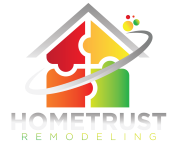 Air Leakage Testing - Maryland Energy Code Compliance |
Blower Door Testing
IECC Air Leakage Air leakage control in new residential homes is an enormous opportunity that the Department of Energy recognizes as a clear way to improve energy efficiency, comfort and safety. The International Energy Conservation Code (IECC) added air sealing as a key provision to meet. Understanding the guidelines and knowing best practices to achieve results are important to the overall success of your new, energy efficient home. Reducing air leakage can improve summer indoor conditions (less humidity) and winter month energy loss can be greatly reduced with proper air sealing. | Air Leakage Basics Air sealing a house is often times misunderstood. Using caulking and other sealant (foam, weatherstripping) can greatly improve the overall "tightness" of a home and the benefits from taking such actions include:
 Open cell spray foam seals & insulates | Mobile VisitorsTesting Requirements The whole house air leakage test is conducted using a blower door system and the conditions of the home must be set up properly for the test to be considered valid. Proper set-up includes setting interior and exterior doors in the proper position, dampers and other gateways shall be closed, but not sealed beyond their intended infiltration control measures (flap, louver) and all appliances must be in the off position. Having the test run by a certified BPI Building Analyst ensures accurate results. A building analyst is trained to identify air leakage in your home and find the right solutions to fix the issues.  Sealing & insulating ducts greatly improves efficiency |
Need a Partner to Provide Third Party Testing?As a licensed Maryland contractor and a certified Building Analysts through the Building Performance Institute (BPI) I can evaluate uncontrolled air leakage into and out of a home and identify heating and cooling problems that lead to high bills and uncomfortable living spaces. Over the past three years I have completed over 3000 hours of relevant work in the field including:
Building a New House in Maryland?
Read this: FROM the DEPARTMENT OF ENERGY: Sealing the building thermal envelope has been required by the energy code for many years (editions of the IECC). However, in years past the provisions were somewhat vague and only required that areas of potential air leakage such as joints, seams, and utility penetrations be sealed with a durable material such as caulking, gasketing, or weather stripping. The 2009 IECC required verification of air sealing by either a visual inspection against a detailed checklist or a whole-house pressure test. The 2012 IECC NOW requires all new construction and additions be both visually inspected and pressure tested as mandatory requirements. There have been some slight changes to the visual inspection checklist and ratcheting down of the testing parameters, requiring houses to be much tighter than the previous edition of the code (see Figure 2 and Table 1). (Source: DOE - Air Leakage Guide | Building Technologies Program)
The majority of the Maryland region falls in climate zone 4 which is now required to test out at equal to or less than 3 ACH (Air Changes per Hour). Air changes per hour can be defined in the following way: the number of times that the complete volume of a home is exchanged for outside air each hour. The less times this happens, the tighter the home and as a result, the more efficient the home. (please be sure to learn about mechanical ventilation for good indoor air quality). 
|









